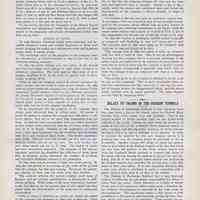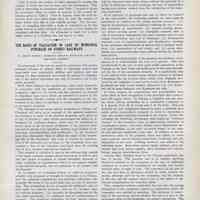Collections Item Detail
Article re Hudson & Manhattan R.R.: Delays to Trains In The Hudson Tunnels. Electric Railway Journal, Nov. 12, 1910.
2014.013.0106
2014.013
Lukacs, Claire
Gift
Museum Collections. Gift of a friend of the Museum.
1910 - 1910
Date(s) Created: 1910 Date(s): 1910
Notes: Archives 2014.013.0106 ==== ELECTRIC RAILWAY JOURNAL. Vol. XXXVI. No. 20. , November 12, 1910. ==== page 997 DELAYS TO TRAINS IN THE HUDSON TUNNELS The Hudson & Manhattan Railroad is now operating more than 2200 trains a day in the tunnels under the Hudson River between New York, Jersey City and Hoboken. This is the largest number of trains operated daily on any double-track railroad in the world. During the rush hours the headway of trains in and out of the Cortlandt Street terminal station is only 1 minute, and the maximum headway of trains between the hours of 6 a. m. and 12 midnight is 2 1/2 minutes. In order to maintain the schedule for this very frequent service it is essential that even the shortest delays be prevented as far as is possible. Another reason why delays to trains are particularly to be avoided in the Hudson tunnels is the fact that trains are run from the stations on the Sixth Avenue branch and from the Cortlandt Street terminal to connect with trains of the steam railroads leaving the stations in Jersey City and Hoboken, and all of the railroads whose stations are reached by the Hudson tunnels now advertise the leaving time of the tube trains in their time tables. It is very important therefore that a tube train which is scheduled to make a connection with a steam railroad train shall be on time to the minute. The Hudson & Manhattan Railroad has a very thorough method of following up and fixing responsibility for delays to trains from any cause. Every detention of a train or failure of any part of the equipment which might cause a detention under ordinary circumstances is reported by the train crews to the trainmaster. The trainmaster makes a daily report of such occurrences to the general superintendent, giving the time, location, nature and cause of the detention. These reports are examined each day by the chief clerk in the general superintendent’s office, and a copy of the statement from the trainmaster concerning each detention is sent to the head of the department which, in the opinion of the trainmaster, was responsible for the detention. These daily reports are investigated promptly by the heads of the departments affected, and a ==== page 998 statement is returned to the general supeintendent’s office, acknowledging the cause of the delay and stating the action taken to prevent a repetition of it, or shifting the blame in whole or in part on some other department. At the end of each month the general superintendent goes over all of the trainmaster’s reports of detentions and the explanations of the department heads, and compiles a table showing the number of detentions and the total number of minutes of detention chargeable to each of the different departments. A copy of this table is sent to the head of each department, with a circular letter of comment by the general superintendent. Two typical letters sent out with this monthly statement are re-printed: “September 9, 1910. “To Mr. D. Sage, Chief Engineer. “ Mr. P. V. See, Superintendent of Car Equipment. “ Mr. J. F. O’Rourke, Trainmaster. “ Mr. C. S. Klumpp, Assistant to General Superintendent. “ Mr. M. H. Collins, Supervisor of Signals. “ Mr. L. G. Smith, Chief Electrician. “Dear Sir: “We were unfortunate during the month of August to have a cable blow-out, causing a delay of 118 minutes. With this exception the work of all departments was excellent. “The power house again leads with a clean sheet. “Car equipment, with 20 minutes, is excellent. “Signals, with 21 1/2 minutes, is also excellent. “The transportation and substation departments suffered owing to the carelessness of some of their men. “Thanking you for the earnest efforts you are making to make our service the very best, I remain, “Yours truly, (Signed) “E. T. Munger, “General Superintendent.” “October 6, 1910. “To Mr. D. Sage, Chief Engineer. “ Mr. P. V. See, Superintendent of Car Equipment. “ Mr. J. F. O’Rourke, Trainmaster. “ Mr. C. S. Klumpp, Assistant to General Superintendent. “ Mr. M. H. Collins, Supervisor of Signals. “ Mr. L. G. Smith, Chief Electrician. “Dear Sir: “I have before me the detentions for the month of September, 1910. The number of detentions was 29 and the total minutes detention 85 1/2. This can be compared with the month of September, 1909, in which month we had 42 detentions, amounting to 171 minutes. The months are directly comparable, for in the month of September last year we opened up the southern division, and in the month of September this year we opened up the western division. “Transportation has 18 minutes’ detention this year against 50 minutes last year. “Car equipment has 18 minutes this year against 64 minutes last year. “The signal department has 10 minutes this year against 43 minutes last year. This is a big improvement for all of the above. “Ten minutes’ detention on signal breaks all records, and I wish to congratulate and thank the signal department. “We are now running 2078 trains a day, which makes the above comparisons all the better. “The power house and substations again come to the front ---- with a clean record, and I wish to congratulate and thank all of the employees in these departments for their good work, and hope they will keep it up. “Again thanking you all, I remain, “Yours truly, (Signed) “E. T. Munger, “General Superintendent.” Praise is given when praise is due, and attention is called to any conditions which in the opinion of the general superintendent require special action. Table I is a summary of the detention reports for eight months, beginning February, 1910. The minutes of detention shown in the table are the minutes of detention to the first train encountering an obstruction or delayed by failure of any part of the equipment. It will be readily understood that with such a close headway a detention of even one or two minutes to one train will cause a delay to a number of following trains, ---- TABLE II.—TRAINS OPERATED AND TRAINS LATE AND ON TIME. Total Number Number Month. Number Trains Trains Trains. Late. Per Cent, on Time. Per Cent. September, 1910..............58,333 257 0.45 58,076 99.55 August, 1910................45,043 148 0.33 44,895 99.67 July, 1910...................44,755 121 0.27 44,634 99.73 June, 1910...................43,6oo 258 0.60 43,342 99.40 May, 1910...................45,859 220 0.48 45,639 99.52 April, 1910...... 44,721 237 0.53 44,484 99.47 March, 1910.......... .46,259 375 0.82 45,884 99.18 February, 1910..............41,443 320 0.77 41,123 99.23 ---- and in case of long detentions it may be some time before all the trains can get back to .their normal schedule. The best record for any month since the road was in operation was made in July, 1910, when there were 20 detentions for a total of 64^ minutes. Occasionally some serious break-down will cause a long detention, which brings the monthly total above the average. Thus in August a cable blow-out caused a single delay of 118 minutes, chargeable to maintenance of way. With this exception the record for August compares favorably with July or September. A great improvement has been made during 1910, as shown by a comparison with the total number of minutes of detentions during the four months previous to February, 1910. In October, 1909, the total detentions were 463 minutes; in November, 1909, 211 minutes; December, 1909, 366 1/2 minutes, and in January, 1910, 145 minutes. The classification of detentions by departments is made very carefully. The transportation department, for example, is charged with all detentions due to errors in the routing made by the signal men in the interlocking towers, failure to load or unload trains promptly and failure to have trains made up in time to leave terminals. The best record made by this department was in May, when it was charged with no detentions. All failures of car equipment due to defective materials or workmanship in making repairs, or to inadequate inspection, are charged to the car equipment department. As will be seen from an examination of the totals, the delays chargeable to this department are greater in number than almost any other department, but they are of comparatively short duration. In no one month since the record was begun has the car equipment department escaped with a clean record. The maintenance-of-way department is charged with all delays due to defective tracks and switches, third-rail and third-rail jumper cables. In February no detentions were charged against this department, and the average for the last eight months is small. ---- TABLE I—CLASSIFICATION OF HUDSON AND MANHATTAN TRAIN DETENTIONS BY DEPARTMENTS FOR EIGHT MONTHS OF 1910 September August July June May April March February Total Total Total Total Total Total Total Total No. Min. No. Min. No. Min. No. Min. No. Min. No. Min. No. Min. No. Mm. Transportation 6 18 5 19 3 6-1/2 7 15 0 0 .. 5 12 1/2 2 Car equipment 7 18 6 20 4 19-1/2 12 12-1/2 11 45-1/2 .. 7 35 1/2 21 Maintenance of way 3 17 3 125 1 2 1 10 3 5 1/2 .. 6 10 1/2 0 Signals 4 10 7 21 1/2 4 13 7 21 1/2 7 11 1/2 • • 67 41 1/2 41 Power house 0 0 0 0 0 0 0 0 0 • • 0 0 0 Substations 0 4 13 1/2 1 2 0 0 0 0 • • 5 6 0 Construction 7 1/2 0 0 0 0 0 0 1 2 • • 2 0 10 Signal construction • 7 15 0 0 1 2 0 0 2 3 1/2 • • 0 0 0 Miscellaneous 0 0 0 5 18 0 0 0 0 • • 5 3 1/2 11 Ticket bureau 0 0 0 1 1 1/2 1 3 0 0 0 0 0 Total 85 1/2 25 199 20 64 1/2 28 92 24 68 97 109 1/2 85 ==== page 999 Delays due to defective signals, including the automatic stop apparatus, have averaged about the same for the last five months. The power house has had an absolutely clean record for eight months, and there have been very few delays chargeable to substations. The detentions listed under miscellaneous include all those which cannot justly be charged to any one of the operating or engineering departments. Table II shows the number of trains operated by months, the number of trains late and on time, and the percentages. This table is interesting in connection with Table I, because it shows the cumulative delays to trains on account of the several detentions given in Table I. Thus in August, while the total detentions were very much larger than for July, the number of trains which were late is only slightly greater. For the purpose of compiling this table a train is considered to be late which arrives at either terminal one minute or more behind its scheduled arriving time. No allowance is made for a train which arrives at a terminal late, but leaves on time. [end] ==== ==== Status: OK Status By: dw Status Date: 2014-11-04




